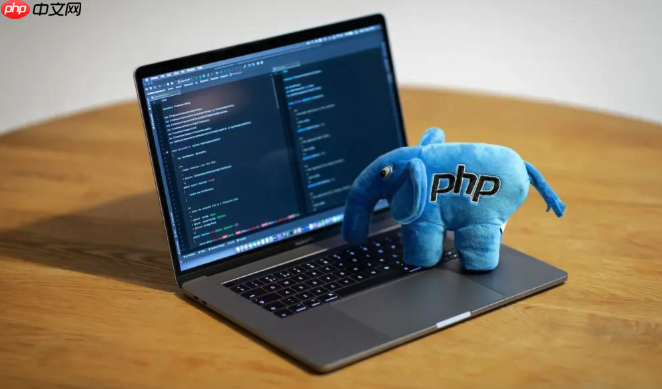PHP文件缓存系统通过将数据序列化存储至文件并设置过期时间,适用于中小型应用中静态内容、数据库查询结果、外部API响应等场景,优势在于实现简单、无外部依赖、成本低且读取速度快。核心机制包括TTL过期控制、主动删除与垃圾回收(GC)协同管理缓存有效性,确保数据一致性并释放磁盘空间。常见陷阱有文件权限问题、缓存雪崩(可通过随机TTL缓解)、高并发下的I/O性能瓶颈及序列化开销,需注意缓存键设计、安全性防护(如禁止Web访问缓存目录)和内存使用。该方案适合对性能要求不极致、部署环境受限的项目,高并发场景下应考虑升级至Redis等专业缓存系统。

PHP实现一个简单的文件缓存系统,核心在于将数据序列化后写入文件,并在读取时反序列化,同时加入过期时间判断。这能有效减轻数据库或API的负载,提升应用响应速度。
<?php
class FileCache
{
private $cacheDir;
private $defaultTtl; // Default Time To Live in seconds
public function __construct(string $cacheDir, int $defaultTtl = 3600)
{
$this->cacheDir = rtrim($cacheDir, '/') . '/';
$this->defaultTtl = $defaultTtl;
if (!is_dir($this->cacheDir)) {
if (!mkdir($this->cacheDir, 0777, true)) {
throw new \RuntimeException("无法创建缓存目录: {$this->cacheDir}");
}
}
if (!is_writable($this->cacheDir)) {
throw new \RuntimeException("缓存目录不可写: {$this->cacheDir}");
}
}
private function getCacheFilePath(string $key): string
{
// 使用md5避免文件名过长或包含非法字符
return $this->cacheDir . md5($key) . '.cache';
}
/**
* 设置缓存数据
* @param string $key 缓存键名
* @param mixed $data 要缓存的数据
* @param int|null $ttl 缓存有效期(秒),如果为null则使用默认值
* @return bool
*/
public function set(string $key, $data, ?int $ttl = null): bool
{
$filePath = $this->getCacheFilePath($key);
$expiresAt = time() + ($ttl ?? $this->defaultTtl);
// 将过期时间与数据一起序列化存储
$cacheData = [
'expires_at' => $expiresAt,
'data' => $data,
];
// 使用file_put_contents和LOCK_EX确保写入原子性
return file_put_contents($filePath, serialize($cacheData), LOCK_EX) !== false;
}
/**
* 获取缓存数据
* @param string $key 缓存键名
* @return mixed|null 如果缓存有效则返回数据,否则返回null
*/
public function get(string $key)
{
$filePath = $this->getCacheFilePath($key);
if (!file_exists($filePath)) {
return null;
}
// 尝试读取并反序列化数据
$content = file_get_contents($filePath);
if ($content === false) {
// 文件可能被删除或权限问题
return null;
}
$cacheData = @unserialize($content);
// 检查反序列化是否成功以及数据结构是否符合预期
if ($cacheData === false || !isset($cacheData['expires_at'], $cacheData['data'])) {
// 缓存文件损坏,删除它
$this->delete($key);
return null;
}
// 检查缓存是否过期
if (time() > $cacheData['expires_at']) {
$this->delete($key); // 过期则删除
return null;
}
return $cacheData['data'];
}
/**
* 删除指定键的缓存
* @param string $key 缓存键名
* @return bool
*/
public function delete(string $key): bool
{
$filePath = $this->getCacheFilePath($key);
if (file_exists($filePath)) {
return unlink($filePath);
}
return true; // 文件不存在也算删除成功
}
/**
* 清空所有缓存
* @return bool
*/
public function clear(): bool
{
$success = true;
foreach (glob($this->cacheDir . '*.cache') as $file) {
if (is_file($file) && !unlink($file)) {
$success = false;
}
}
return $success;
}
/**
* 手动清理过期缓存文件,而不是等待被访问时删除
* 通常通过cron job调用
*/
public function gc(): void
{
foreach (glob($this->cacheDir . '*.cache') as $filePath) {
if (!is_file($filePath)) {
continue;
}
$content = file_get_contents($filePath);
if ($content === false) {
// 无法读取,可能文件损坏或权限问题,尝试删除
@unlink($filePath);
continue;
}
$cacheData = @unserialize($content);
if ($cacheData === false || !isset($cacheData['expires_at'])) {
// 文件损坏,删除它
@unlink($filePath);
continue;
}
if (time() > $cacheData['expires_at']) {
@unlink($filePath); // 过期则删除
}
}
}
}
// 使用示例:
// $cache = new FileCache(__DIR__ . '/cache_data', 600); // 缓存目录,默认TTL 10分钟
// // 设置缓存
// $dataToCache = ['name' => 'John Doe', 'age' => 30];
// $cache->set('user_profile_123', $dataToCache, 300); // 缓存5分钟
// // 获取缓存
// $cachedData = $cache->get('user_profile_123');
// if ($cachedData) {
// echo "从缓存获取: " . json_encode($cachedData) . "\n";
// } else {
// echo "缓存未命中或已过期\n";
// // 假设这里是从数据库或API获取数据
// $freshData = ['name' => 'Jane Doe', 'age' => 25, 'timestamp' => time()];
// $cache->set('user_profile_123', $freshData, 300);
// echo "数据已重新缓存\n";
// }
// // 删除特定缓存
// // $cache->delete('user_profile_123');
// // 清空所有缓存
// // $cache->clear();
// // 运行垃圾回收(例如通过cron job每小时运行一次)
// // $cache->gc();
?>这个
FileCache
set
get
delete
clear
gc
从我的经验来看,PHP文件缓存系统非常适合那些中小型、对性能有一定要求但又不想引入复杂外部依赖的应用。比如,一个个人博客、小型企业官网,或者一些内部管理系统,它们的访问量可能不是特别高,但页面生成涉及多次数据库查询或外部API调用。
适用场景:
立即学习“PHP免费学习笔记(深入)”;
优势所在:
当然,它也有局限性,比如在高并发场景下可能会遇到文件锁竞争,或者磁盘I/O成为瓶颈。但对于绝大多数“够用就行”的应用,它无疑是一个快速、有效的解决方案。
管理缓存的过期和失效,是缓存系统最核心也最容易出问题的地方。我见过不少应用因为缓存失效策略没做好,导致用户看到旧数据,或者缓存雪崩把服务器搞崩。在文件缓存里,我们有几种方式来处理:
基于时间的过期(TTL): 这是最基本的。就像我们上面代码里做的,
set
get
null
主动删除(Invalidation): 当原始数据发生变化时,我们应该主动去删除对应的缓存文件。例如,如果更新了一篇博客文章,就应该立即调用
$cache->delete('blog_post_id_X')category_X_page_Y
user_profile_123_v2
垃圾回收(Garbage Collection, GC): 就像我代码里
gc()
get
$cache->gc()
原子性操作: 在更新缓存时,尤其要小心并发问题。比如,一个请求正在生成新的缓存文件,另一个请求却读到了一个不完整的旧文件。
file_put_contents
LOCK_EX
综合来看,一个健壮的文件缓存系统需要TTL、主动失效和后台垃圾回收三者协同工作,才能确保缓存的有效性、一致性和磁盘空间的合理利用。
在实现PHP文件缓存时,我遇到过一些坑,也总结了一些性能上的考量。这些往往是初学者容易忽视,但对系统稳定性至关重要的点。
文件权限问题: 这是最常见的。缓存目录必须是PHP进程可写的,否则
file_put_contents
0777
0775
umask
缓存雪崩与击穿:
get
磁盘I/O性能: 文件缓存的性能瓶颈通常在于磁盘I/O。
flock
序列化与反序列化开销: PHP的
serialize()
unserialize()
json_encode
json_decode
缓存键管理: 确保缓存键的唯一性和可读性。使用
md5()
安全性:
内存消耗: 虽然数据存在文件里,但在PHP脚本运行时,读取和反序列化后的数据会加载到内存中。如果缓存了大量大对象,可能会导致PHP进程内存占用过高。
总的来说,文件缓存是一个“够用就好”的解决方案。在设计时,要充分理解它的优势和局限性,并针对性地进行优化和规避风险。当应用规模和并发量达到一定程度时,可能就需要考虑迁移到更专业的缓存系统,如Redis或Memcached了。
以上就是PHP如何实现一个简单的缓存系统_PHP文件缓存系统实现方法的详细内容,更多请关注php中文网其它相关文章!

PHP怎么学习?PHP怎么入门?PHP在哪学?PHP怎么学才快?不用担心,这里为大家提供了PHP速学教程(入门到精通),有需要的小伙伴保存下载就能学习啦!

Copyright 2014-2025 https://www.php.cn/ All Rights Reserved | php.cn | 湘ICP备2023035733号